All issues

Volume 39, Issue 1
Displaying 1-3 of 3 articles from this issue
- |<
- <
- 1
- >
- >|
-
Article type: Photogravure
1994 Volume 39 Issue 1 Pages App6-
Published: March 10, 1994
Released on J-STAGE: March 20, 2017
JOURNAL FREE ACCESSDownload PDF (2066K) -
Isao TAKASHIMA, Koichiro WATANABEArticle type: Article
1994 Volume 39 Issue 1 Pages 1-12
Published: March 10, 1994
Released on J-STAGE: March 20, 2017
JOURNAL FREE ACCESSThermoluminescence (TL) age determination was carried out for 40 lava samples, one quartz vein and 8 samples from collapsed materials (pyroclastic/debris flow and avalanche deposits) in the Unzen area. The TL growth curve method was used for quartz phenocrysts and vein quartz of the above rocks to determine the ages within the maximum error of 30%. The Unzen volcanic rocks consist of the basal volcanic rocks and the overlying three groups (Takadake, Kusenbudake, and Fugendake in order of formation). The basal volcaniclastic rocks range in age from 230 to 180 ka, overlapping with the age of Takadake group (290 to 180 ka), and with the lower subgroup of Kusenbudake. The Kusenbudake group is classified into the lower subgroup in the western part (190 to 130 ka) and the upper subgroup in the eastern part (130 to 99 ka). The activity of the Fugendake group occurred from 86 to 55 ka in the periphery, resulting in the formation of lower subgroup, and concentrated in the center around 15 to 10 ka, upper subgroup. The age of Mayuyama in the Fugendake group which was under debate among many researchers was determined as 2.7 to 3.4 ka. This supports the stratigraphic relation of Mayuyama. Based on the TL age determination results and chemical compositions (U, Th and K contents) of the bulk rocks, the supplying sources of collapsed materials were identified successfully. The Kinugasayama volcanic rocks are characterized by low U content and high Th content, while those of Fugendake and Mayuyama are characterized by high levels of U and Th contents.View full abstractDownload PDF (1160K) -
Kayoko SUGAArticle type: Article
1994 Volume 39 Issue 1 Pages 13-24
Published: March 10, 1994
Released on J-STAGE: March 20, 2017
JOURNAL FREE ACCESSHachijojima is located on the volcanic front of the Izu-Ogasawara Arc and consists of two volcanoes, Higashiyama and Nishiyama which are built up by mainly basaltic lavas and pyroclastic materials. Topographic features and eruptive history of Higashiyama Volcano are complicated because the volcano has several old edifices and calderas. The activity of main stratovolcano of Higashiyama started probably several tens thousands years ago. The eruptive history of Higashiyama Volcano after completion of the main stratovolcano is divided into next five stages ; Noboryotoge (before 22,000 y. B. P.), Sueyoshi I (22,000 y. B. P.), Sueyoshi II, Nakanogo and Mitsune (10,000-4,000 y. B. P.) Stages. In Noboryotoge Stage thick pyroclastic deposits, mainly scoria fall, were deposited on the northeastern part of Higashiyama. In Sueyoshi I Stage a debris avalanche, pyroclastic flow and fall occured in succession. Nishihakuunzan Caldera might be formed as the result of this eruption. In Sueyoshi II Stage small eruptions and phreatic explosions lasted, and a new edifice, Mihara Volcano formed in Nishihakuunzan Caldera. In Nakanogo Stage scoria fall eruptions took place at the central crater and flank, and lavas and pyroclastic flows flowed down into southern part of Higashiyama. The latest activities of Higashiyama Volcano in Mitsune Stage were all flank eruptions. The total volume of volcanic products of Higashiyama Volcano is 14.3 km3, and the eruption rate during past 22,000 years is 0.22 km3/1,000 years.View full abstractDownload PDF (19665K)
- |<
- <
- 1
- >
- >|